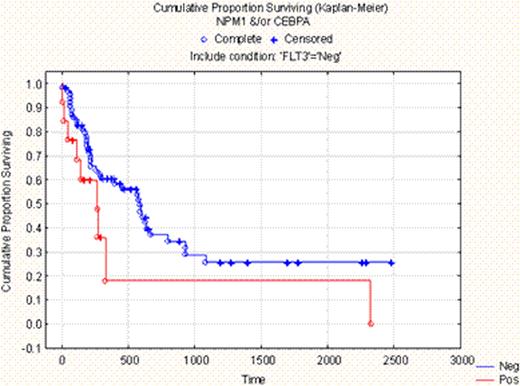Abstract
Abstract 4874
Acute Myeloid Leukemia (AML) is the most common type of acute leukemia in adults. About 50% of patients with AML have normal karyotype, and are categorized as intermediate risk group. However, the clinical behavior and response to treatment in this group is heterogeneous. As a result, there is strong interest in characterizing molecular genetic features in the intermediate-risk AML patients that might rectify their stratification risk. In this group, FLT3-ITD (Internal Tandem Duplication) and FLT3-TKD (Tyrosine Kinase Domain) mutations are known to confer unfavorable risk whereas NPM1 and CEBPA mutations are known to be favorable risk markers. The purpose of this study is to analyze the combination of NPM1 and CEBPA mutations in presence or absence of FLT3 mutations on prognosis of AML patients referred to the State's largest tertiary care center over a period of 10 years for the treatment of leukemia.
We performed a retrospective chart review of all patients with AML evaluated at University of Oklahoma Health Sciences Center between January 2000 and December 2010. Patient's age, gender, race, laboratory and clinical data as well as bone marrow biopsy and aspirate findings were reported. PCR and Fragment Analysis were conducted on all available DNA preserved bone marrow materials to test the FLT3, NPM1 and CEBPA mutations. For statistical analysis, Kaplan-Meyer curve was used.
A total of 239 patients were evaluated. Male to female ratio was 2/1. Median age at diagnosis was 46y. 21 out of the 239 patients were less than 18 year old. DNA samples were present on 132 patients and mutation analysis for FLT3, CEBPA and NPM1 was performed. Correlation between mutations and AML prognosis was determined. 67/132 (50.8 %) patients were categorized into intermediate risk group (majority of patients had normal cytogenetics). 14/67 (20.9%) pts were FLT3+ (FLT3-ITD or FLT3-TKD mutation). 17/67 (23.9%) were NPM1+. 7/67 (10.4%) were CEBPA +. Kaplan-Meier curve was used to identify cumulative proportion surviving over time. FLT3 presence or absence itself was not identified to be statistically significant (p 0.416) in terms of overall survival. Interestingly, presence or absence of combined NPM1/CEBPA mutation in FLT3 negative patients, among intermediate risk group, was found to be statistically significant (p<0.05) in determining overall survival. In this subgroup, presence of NPM1/CEBPA combination (NPM1+/CEBPA+) was associated with poor prognosis (figure 2, lower curve), while absence of NPM1/CEBPA combination (NPM1-/CEBPA-) carries a better prognosis (figure 2, upper curve).
NPM1/CEBPA combination in FLT3 neg, among all patients tested
p = 0.138
NPM1+/CEBPA+
NPM1-/CEBPA-
NPM1/CEBPA combination in FLT3 neg, among all patients tested
p = 0.138
NPM1+/CEBPA+
NPM1-/CEBPA-
NPM1/CEBPA combination in FLT3 neg, among intermediate risk group
P<0.05
NPM1+/CEBPA+
NPM1-/CEBPA-
NPM1/CEBPA combination in FLT3 neg, among intermediate risk group
P<0.05
NPM1+/CEBPA+
NPM1-/CEBPA-
Results of our study highlight the importance of performing combinations of mutation analysis in evaluation of overall prognosis in AML patients. FLT3-/NPM1+ profile in patients with normal cytogenetics is thought to confer a favorable prognosis. We demonstrated in this study that using combination mutation analysis in patients with FLT3- can change the risk stratification in patients with intermediate risk group and might affect therapeutic interventions in this patient population.
Larger prospective studies are needed in the future for further validation of our findings.
No relevant conflicts of interest to declare.
Author notes
Asterisk with author names denotes non-ASH members.



This feature is available to Subscribers Only
Sign In or Create an Account Close Modal